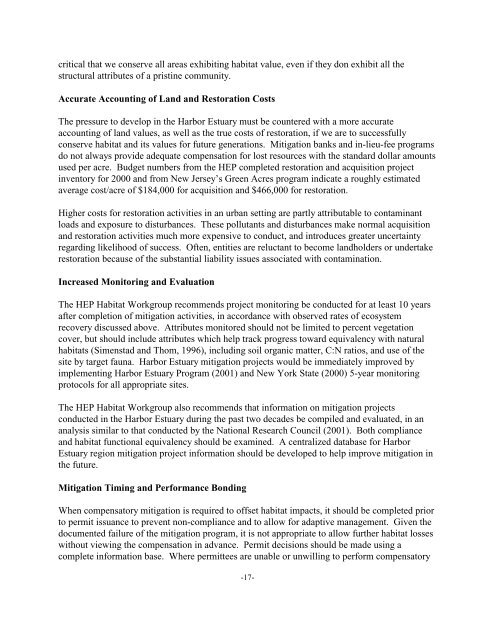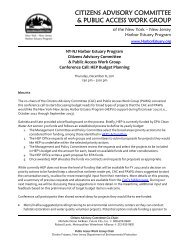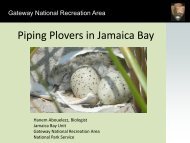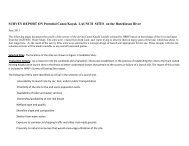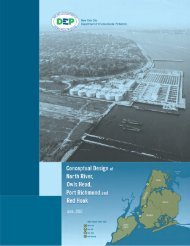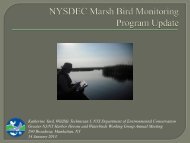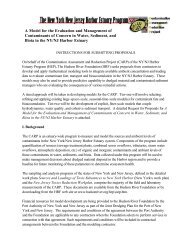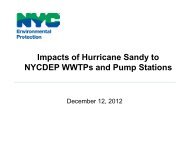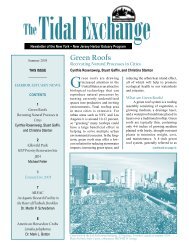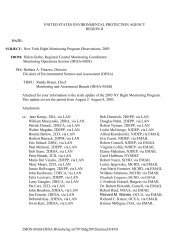DraftMitigation .pdf - New York-New Jersey Harbor Estuary Program
DraftMitigation .pdf - New York-New Jersey Harbor Estuary Program
DraftMitigation .pdf - New York-New Jersey Harbor Estuary Program
Create successful ePaper yourself
Turn your PDF publications into a flip-book with our unique Google optimized e-Paper software.
critical that we conserve all areas exhibiting habitat value, even if they don exhibit all the<br />
structural attributes of a pristine community.<br />
Accurate Accounting of Land and Restoration Costs<br />
The pressure to develop in the <strong>Harbor</strong> <strong>Estuary</strong> must be countered with a more accurate<br />
accounting of land values, as well as the true costs of restoration, if we are to successfully<br />
conserve habitat and its values for future generations. Mitigation banks and in-lieu-fee programs<br />
do not always provide adequate compensation for lost resources with the standard dollar amounts<br />
used per acre. Budget numbers from the HEP completed restoration and acquisition project<br />
inventory for 2000 and from <strong>New</strong> <strong>Jersey</strong>’s Green Acres program indicate a roughly estimated<br />
average cost/acre of $184,000 for acquisition and $466,000 for restoration.<br />
Higher costs for restoration activities in an urban setting are partly attributable to contaminant<br />
loads and exposure to disturbances. These pollutants and disturbances make normal acquisition<br />
and restoration activities much more expensive to conduct, and introduces greater uncertainty<br />
regarding likelihood of success. Often, entities are reluctant to become landholders or undertake<br />
restoration because of the substantial liability issues associated with contamination.<br />
Increased Monitoring and Evaluation<br />
The HEP Habitat Workgroup recommends project monitoring be conducted for at least 10 years<br />
after completion of mitigation activities, in accordance with observed rates of ecosystem<br />
recovery discussed above. Attributes monitored should not be limited to percent vegetation<br />
cover, but should include attributes which help track progress toward equivalency with natural<br />
habitats (Simenstad and Thom, 1996), including soil organic matter, C:N ratios, and use of the<br />
site by target fauna. <strong>Harbor</strong> <strong>Estuary</strong> mitigation projects would be immediately improved by<br />
implementing <strong>Harbor</strong> <strong>Estuary</strong> <strong>Program</strong> (2001) and <strong>New</strong> <strong>York</strong> State (2000) 5-year monitoring<br />
protocols for all appropriate sites.<br />
The HEP Habitat Workgroup also recommends that information on mitigation projects<br />
conducted in the <strong>Harbor</strong> <strong>Estuary</strong> during the past two decades be compiled and evaluated, in an<br />
analysis similar to that conducted by the National Research Council (2001). Both compliance<br />
and habitat functional equivalency should be examined. A centralized database for <strong>Harbor</strong><br />
<strong>Estuary</strong> region mitigation project information should be developed to help improve mitigation in<br />
the future.<br />
Mitigation Timing and Performance Bonding<br />
When compensatory mitigation is required to offset habitat impacts, it should be completed prior<br />
to permit issuance to prevent non-compliance and to allow for adaptive management. Given the<br />
documented failure of the mitigation program, it is not appropriate to allow further habitat losses<br />
without viewing the compensation in advance. Permit decisions should be made using a<br />
complete information base. Where permittees are unable or unwilling to perform compensatory<br />
-17-


